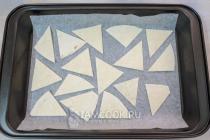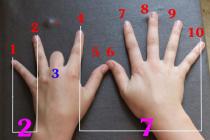Those who are engaged in radio electronics at home are usually very curious. Amateur radio circuits and homemade products will help you find a new direction in creativity. Perhaps someone will find an original solution to this or that problem. Some homemade products use ready-made devices, connecting them in various ways. For others, you need to completely create the circuit yourself and make the necessary adjustments.
One of the most simple homemade products... More suitable for those who are just starting to tinker. If you have an old, but working cell push-button telephone with a button to turn on the player, you can make, for example, a doorbell to your room from it. The advantages of such a call:

First, you need to make sure that the selected phone is capable of producing a sufficiently loud melody, after which it must be completely disassembled. Basically, the parts are fastened with screws or brackets, which are carefully folded back. When disassembling, you will need to remember what is going on for what, so that later you can collect everything.
The player's power button is soldered on the board, and instead of it two short wires are soldered. Then these wires are glued to the board so as not to rip off the solder. The phone is going. It remains to connect the phone to the call button through a two-wire wire.
Homemade products for cars
Modern cars are equipped with everything you need. However, there are times when you just need homemade devices... For example, something broke, given to a friend and the like. Then the ability to create electronics with your own hands at home will be very useful.
The first thing you can interfere with without fear of damaging your car is the battery. If at the right time the charging for the battery was not at hand, you can quickly assemble it yourself. This will require:

A transformer from a tube TV is ideal. Therefore, those who are addicted to homemade electronics never throw away electrical appliances in the hope that they will be needed someday. Unfortunately, there are two types of transformers used: with one and with two coils. Anyone will go to charge a 6 volt battery, and only two for 12 volts.
The wrapping paper of such a transformer shows the winding leads, the voltage for each winding, and the operating current. To power the filaments of electronic lamps, a voltage of 6.3 V with a high current is used. The transformer can be altered by removing the extra secondary windings, or left as it is. In this case, the primary and secondary windings are connected in series. Each primary is designed for a voltage of 127 V, therefore, combining them, they get 220 V. The secondary ones are connected in series to get 12.6 V.
The diodes must withstand a current of at least 10 A. Each diode requires a radiator with an area of at least 25 square centimeters. They are connected to a diode bridge. Any electrical insulating plate is suitable for fastening. A 0.5 A fuse is included in the primary circuit, and a 10 A fuse in the secondary circuit. The device does not tolerate a short circuit, therefore, when connecting the battery, the polarity should not be confused.
Simple heaters
In the cold season, it may be necessary to warm up the engine. If the car is parked where there is an electric current, this problem can be solved by using a heat gun. To make it you will need:
- asbestos pipe;
- nichrome wire;
- fan;
- switch.

The diameter of the asbestos pipe is chosen according to the size of the fan to be used. The performance of the heater will depend on its power. The length of the pipe is everyone's preference. You can assemble a heating element and a fan in it, you can only a heater. When choosing the last option, you will have to think about how to start up the air flow to the heating element. This can be done, for example, by placing all the components in a sealed enclosure.
Nichrome wire is also picked up by the fan. The more powerful the latter, the larger diameter nichrome can be used. The wire is twisted into a spiral and placed inside the pipe. For fastening, bolts are used that are inserted into pre-drilled holes in the pipe. The length of the spiral and their number are chosen empirically. It is desirable that the spiral does not get red-hot when the fan is running.
The choice of the fan will determine what voltage needs to be applied to the heater. When using a 220 V electric fan, you will not need to use an additional power source.
 The entire heater is connected to the network via a cord with a plug, but it itself must have its own switch. It can be either just a toggle switch or an automatic machine. The second option is more preferable, it allows you to protect common network... For this, the trip current of the machine must be less than the operating current of the room machine. The switch is also needed to quickly turn off the heater in case of malfunctions, for example, if the fan does not work. This heater has its drawbacks:
The entire heater is connected to the network via a cord with a plug, but it itself must have its own switch. It can be either just a toggle switch or an automatic machine. The second option is more preferable, it allows you to protect common network... For this, the trip current of the machine must be less than the operating current of the room machine. The switch is also needed to quickly turn off the heater in case of malfunctions, for example, if the fan does not work. This heater has its drawbacks:
- harm to the body from asbestos pipes;
- fan noise;
- smell from dust falling on a heated coil;
- fire hazard.
Some problems can be solved by using another homemade product. Instead of an asbestos pipe, you can use a coffee can. To prevent the spiral from closing on the jar, it is attached to a textolite frame, which is fixed with glue. A cooler is used as a fan. To power it, you will need to assemble another electronic device - a small rectifier.
Homemade products bring not only satisfaction to those who are engaged in them, but also benefit. With their help, you can save energy, for example, by turning off electrical appliances that you forgot to turn off. A time relay can be used for this purpose.
The easiest way to create a timing element is to use the time to charge or discharge the capacitor through the resistor. Such a chain is included in the base of the transistor. The following details are required for the diagram:
- electrolytic capacitor large capacity;
- transistor type p-n-p;
- electromagnetic relay;
- diode;
- variable resistor;
- fixed resistors;
- constant current source.

First, you need to determine what current will be switched through the relay. If the load is very powerful, you will need a magnetic starter to connect it. The starter coil can be connected via a relay. It is important that the relay contacts can work freely without sticking. A transistor is selected according to the selected relay, it is determined with what current and voltage it can work. You can focus on KT973A.
The base of the transistor is connected through a limiting resistor to a capacitor, which in turn is connected through a bipolar switch. The free contact of the switch is connected through a resistor with a minus supply. This is necessary to discharge the capacitor. The resistor acts as a current limiter.
The capacitor itself is connected to the positive rail of the power supply through a variable resistor with high resistance. By selecting the capacitance of the capacitor and the resistance of the resistor, you can change the delay time interval. The relay coil is shunted by a diode, which turns on in the opposite direction. This circuit uses KD 105 B. It closes the circuit when the relay is de-energized, protecting the transistor from breakdown.
 The scheme works as follows. V original state the base of the transistor is disconnected from the capacitor and the transistor is off. When the switch is turned on, the base is connected to the discharged capacitor, the transistor opens and supplies voltage to the relay. The relay operates, closes its contacts and supplies voltage to the load.
The scheme works as follows. V original state the base of the transistor is disconnected from the capacitor and the transistor is off. When the switch is turned on, the base is connected to the discharged capacitor, the transistor opens and supplies voltage to the relay. The relay operates, closes its contacts and supplies voltage to the load.
The capacitor begins to charge through a resistor connected to the positive terminal of the power supply. As the capacitor charges, the base voltage begins to rise. At a certain voltage value, the transistor closes, de-energizing the relay. The relay disconnects the load. For the circuit to work again, you need to discharge the capacitor, for this switch the switch.
If you think that homemade products are the lot of toddlers and bored housewives, we will very quickly dispel your misconceptions. This section is entirely devoted to the manufacture of homemade products from car parts and rubber tires. Almost anything can be made from a tire. From garden shoes to a full-fledged playground with swings, fairy-tale characters and elements for relaxation. Finally, the always busy dads will have the opportunity to show their creative talents and create something useful and beautiful on their own personal plot or backyard.
Car tires tend to become unusable, especially given the domestic quality of roads and sudden temperature changes. Instead of sending an old tire to a landfill, it can be slightly transformed and given new life on the playground, in the garden or vegetable garden.
We have collected a huge number of examples of how to do car homemade products using tires for various household and aesthetic purposes. Perhaps one of the most popular ways to use your old tire is the arrangement of playgrounds. The easiest option is to dig in half a row of tires and paint their upper part in bright colors. The architectural element created in this way will be used by kids as a device for walking and jogging with obstacles, as well as instead of "furniture", because sand products can be laid out on the surface of the tire, or even sit by yourself, resting on a quiet summer evening.
You can aesthetically diversify the exterior of the site by creating fairy dragons, funny bears that will greet your guests at the entrance to the courtyard, crocodiles and other animals lurking in the garden with the help of tires. For flower lovers, a car tire can replace a full-fledged flowerpot, and the plants planted in it will give the yard a well-groomed look.
You can delight children by creating a comfortable swing from the best-preserved tires. You can leave the shape of the tire in its original form, and, with a little more time and effort, create an unusual swing in the form of horses.
Whatever you choose to create a car craft, your children will in any case be delighted to see a homemade car for a car in the yard. Inventive kids will be able to play new games, and will definitely be proud of their folder, showing off your creation to friends. And the mixing of happiness and pride in you in the eyes of a child is perhaps the only thing for which you can step on the throat of a long-awaited weekend in the company of a sofa, TV and beer.
One of the common hobbies of hobbyists and electronics professionals is the design and manufacture of various homemade products for the home. Electronic homemade products do not require large material and financial costs and can be performed at home, since work with electronics is, for the most part, "clean". The only exception is the manufacture of various body parts and other mechanical assemblies.
Useful electronic homemade products can be used in all areas of everyday life, from the kitchen to the garage, where many are engaged in the improvement and repair of electronic devices in a car.
Homemade products in the kitchen
Electronic homemade kitchens can be added to existing accessories and supplies. Industrial and home-made electric BBQ grills are very popular among apartment residents.

Another common example of homemade kitchens made by a home electrician is timers and automatic lighting over work surfaces, electric ignition of gas burners.
Important! Changing the design of some household appliances, especially gas appliances, can cause "misunderstanding and rejection" of regulatory organizations. It also requires great care and attention.
Electronics in the car
Homemade devices for a car are most widespread among the owners of domestic brands of transport, which differ in the minimum number additional functions. The following schemes are in wide demand:
- Sound indicators of turns and hand brake;
- Operating mode indicator battery and a generator.

More experienced radio amateurs are engaged in equipping their car with parking sensors, electronic window drives, automatic light sensors to control low beam headlights.
Homemade products for beginners
Most novice radio amateurs are engaged in the manufacture of structures that do not require high qualifications. Simple proven designs can serve for a long time and not only for the sake of benefit, but also as a reminder of the technical "maturation" from a novice radio amateur to a professional.
For inexperienced hobbyists, many manufacturers produce ready-made design kits that contain a printed circuit board and a set of elements. Such kits allow you to practice the following skills:
- Reading circuit and wiring diagrams;
- Correct soldering;
- Adjustment and adjustment according to the ready-made method.
Among the sets are very common Digital Watch different versions and degrees of complexity.

As an area of application of knowledge and experience, radio amateurs can design electronic toys using simpler circuits or reworking industrial structures to their wishes and capabilities.
Interesting ideas for crafts can be seen in the examples of making radio electronic crafts from worn-out parts of computer technology.
Home workshop
For the independent design of radio electronic devices, a certain minimum of tools, fixtures and measuring devices are required:
- Soldering iron;
- Side cutters;
- Tweezers;
- Screwdriwer set;
- Pliers;
- Multifunctional tester (avometer).
On a note. When planning to do electronics with your own hands, you should not tackle complex structures right away and purchase an expensive tool.
Most radio amateurs began their journey with the use of the simplest soldering iron 220V 25-40W, and from the measuring instruments in the home laboratory, the most massive Soviet tester Ts-20 was used. All this is enough for practicing with electricity, acquiring the necessary skills and experience.

It makes no sense for a novice radio amateur to buy an expensive soldering station if there is no necessary experience with a conventional soldering iron. Moreover, the possibility of using the station will not appear soon, but only after sometimes quite a long time.
Also, there is no need for professional measuring equipment. The only serious instrument that even a novice hobbyist may need is an oscilloscope. For those already versed in electronics, the oscilloscope is one of the most sought after measurement tools.

Inexpensive Chinese-made digital devices can be successfully used as an avometer. Having rich functionality, they have high measurement accuracy, ease of use and, what is important, have a built-in module for measuring transistor parameters.
Speaking of a homemade workshop at a homemade product, one cannot fail to mention the materials used for soldering. This is solder and flux. The most widespread solder is POS-60 alloy, which has a low melting point and ensures high soldering reliability. Most of the solders used for soldering all kinds of devices are analogs of the mentioned alloy and can be successfully replaced by it.
As a flux for soldering, ordinary rosin is used, but for ease of use it is better to use its solution in ethyl alcohol. Rosin-based fluxes do not need to be removed from the installation after work, since they are chemically neutral under most operating conditions, and a thin rosin film formed after the evaporation of the solvent (alcohol) exhibits good protective properties.
Important! When soldering electronic components under no circumstances should active fluxes be used. This is especially true of soldering acid (zinc chloride solution), since even under normal conditions such a flux has a destructive effect on thin copper printed conductors.
For maintenance of highly oxidized leads, it is better to use active acid-free flux LTI-120, which does not require rinsing.
It is very convenient to work using solder, which includes a flux. The solder is made in the form of a thin tube with rosin inside.

Breadboards made of double-sided foil-clad fiberglass, which are produced in a wide range, are well suited for the installation of elements.

Security measures
Electricity is associated with a risk to health and even life, especially if do-it-yourself electronics are designed with a mains supply. Homemade electrical devices must not use a transformerless AC mains supply. In an extreme case, the adjustment of such devices should be done by connecting them to the network through an isolation transformer with a transformation ratio equal to one. The voltage at its output will correspond to the mains, but at the same time, reliable galvanic isolation will be provided.
Every day it becomes more and more, there are many new articles, it is quite difficult for new visitors to immediately navigate and revise everything that has already been written and previously posted at a time.
I would very much like to draw the attention of all visitors to individual articles that were posted on the site earlier. In order not to have to search for a long time necessary information I will make several "entry pages" with links to the most interesting and useful articles on specific topics.
Let's call the first such page "Useful electronic homemade products". Simple electronic circuits are considered here, which are available for implementation by people of all skill levels. The circuits are built using a modern electronic base.
All information in the articles is presented in a very accessible form and to the extent necessary for practical work... Naturally, to implement such schemes, you need to understand at least the basics of electronics.
So, a selection of the most interesting articles on the site by topic "Useful electronic homemade products"... The author of the articles is Boris Aladyshkin.
The modern element base of electronics greatly simplifies the circuitry. Even an ordinary twilight switch can now be assembled from just three parts.
The article describes a simple and reliable electric pump control scheme. Despite the extreme simplicity of the circuit, the device can operate in two modes: water rise and drainage.
The article contains several schemes of spot welding machines.
With the help of the described structure, it is possible to determine whether or not a mechanism located in another room or building is working. The vibration of the mechanism itself is information about the work.
A story about what a safety transformer is, what it is for and how you can make it yourself.
Description of a simple device that disconnects the load if the mains voltage goes out of range.
The article describes a circuit of a simple thermostat using an adjustable zener diode TL431.
An article on how to make a device for smoothly switching on lamps using the KR1182PM1 microcircuit.
Sometimes, with reduced voltage in the network or soldering of massive parts, it becomes simply impossible to use a soldering iron. This is where a step-up power regulator for a soldering iron can come to the rescue.
An article about what can be replaced mechanical thermostat oil heating radiator.
Description of a simple and reliable thermostat circuit for a heating system.
The article provides a description of the converter circuit made on a modern element base, containing a minimum number of parts and allowing to obtain significant power in the load.
An article about various ways to connect a load to a control unit on microcircuits using relays and thyristors.
Description of a simple control circuit for LED garlands.
The design of a simple timer that allows you to turn on and off the load at specified time intervals. The working time and the pause time do not depend on each other.
Description of the circuit and principle of operation of a simple emergency luminaire based on an energy-saving lamp.
A detailed story about the popular "laser-iron" manufacturing technology printed circuit boards, its features and nuances.
Electronic homemade products, for today, are in an accessible way making useful mechanisms that can make life easier and diversify leisure. Modern craftsmen are able to assemble both simple toys and complex, multitasking mechanisms with their own hands. How to easily and quickly make electronic toys, interesting and useful electronic homemade products for your home and car with your own hands - read below!
Simple DIY electronics: making a spinner
Electrical engineering is widely used today for both practical and recreational purposes. Some inventions (such as, for example, a “smart home” system) will be quite difficult for a beginner to make. They require experience and in-depth knowledge of physics. Other designs are simple and affordable for novice radio amateurs. So, for example, you can make interesting toys with your own hands - spinners, the sales of which have increased incredibly this year.
To assemble a toy, you will need to stock up on:
- Wooden blank 9x4x1.2 cm;
- Bearing 2.2x0.8x0.7 cm (with rubber seal);
- Two RGB LEDs;
- Two batteries and CR2032 holders;
- Stainless steel bolt 0.8x2 cm;
- Cap nuts M8.
After that, you can get to work. First of all, you will need to find a design diagram on the Internet, and transfer it to an untreated block - a blank. To correctly mark the technological holes (there will be three of them), you will need a ruler.

Then follows:
- Drill a 2.2 cm through hole in the middle of the workpiece for the bearing;
- Drill two holes with a diameter of 2.5 cm and a depth of 7.5 mm on the sides of the workpiece;
- Using a drill, make two blind holes with a diameter of 6 mm for LEDs in the middle of two blinds;
- Process the holes with a countersink;
- Give the toy a rounded shape using a jigsaw, band saw or jigsaw;
- Sand the workpiece with sandpaper, and cover it with varnish;
- Solder the LEDs to the battery holders;
- Check the LEDs, and install them in the mounting holes, fixing them with super glue;
- Clean the bearing, and treat its insides with WD 40;
- Cut off the head of the bolt, and fix the axle in the bearing on both sides with nuts;
- Install the bearing into the bore.
The spinner is ready! The toy will be interesting not only for children. Adults can also use such an electronic device: the device, while rotating, will help to relax or be distracted.
Simple circuits of electronic homemade products: making an electric call
You can make an electric call quite simply and quickly with your own hands.
Such a call will last a long time and will delight the ear. Indeed, when pressed, it will be able to create signals of different frequencies and tones.
So, an electric call can be single-tone and multi-tone.
The ability of a call to reproduce sound in one or several tones will be affected by the presence in the radio design of a multivibrator with two bipolar transistors. Let's consider in detail the scheme of an electronic call with a complex sound signal.
So, electronic homemade scheme will consist of the following radio components:
- Step-down transformer of the TA series;
- Bell button;
- Five fused silicon diodes;
- 1000 microfarad electrolytic capacitor
- Two electrolytic capacitors with a capacity of 10 microfarads;
- Two trimming resistors with a resistance of 470 kilo-ohms;
- Two MLT resistors with a resistance of 10 kilo-ohms;
- Two MLT resistors with a resistance of 33 kilo-ohms;
- 1 kilo-ohm MLT resistor;
- Resistor MLT at 470 kilo-ohms;
- Three silicon-plenary transistors of type 630D
- Silicon planar transistor type 630G.
The principle of operation of the device is simple. Pressing the button will open the third 630D transistor, allowing current to flow to the fourth 630G transistor. This will create the primary signal. When the second transistor of the 630D type is opened, the third and fourth transistors will be locked, creating a signal of a different tonality.
DIY homemade products for a car
Car electronics, today, is in great demand. At the same time, home-made automation often has simple schemes, easy execution and installation. What kind of electric self-made products can you make yourself for your car?
So, you can do it yourself for a car:
- Dynamic turn signals using the KIT DIY constructor;
- Universal Charger from old electronics;
- Air conditioner based on a water pump;
- Heated wipers and more.
The easiest way would be to design the lights for the seat belt buckles. To do this, it will be necessary to dismantle and disassemble the locks using a flat screwdriver. After that, with the help of hot glue in the locks, it is necessary to fix the LEDs.
Each LED can be switched on through its own current limiting resistor: this will extend the life of the semiconductor light emitting device.
After that, the locks should be assembled, and the wires supplying the LEDs should be pulled under the seats to the ignition or the size button through the cigarette lighter. At the request of the owner, the car interior lighting can be supplemented with lamps that signal that the seat belt is not fastened.
Unusual electronic homemade products: do-it-yourself binary clock
You can make a cool binary clock for your home with your own hands. This requires the Arduino platform. Circuits on this platform are simple and convenient, they are used for the manufacture of most electronic homemade products.

In addition, to make a binary clock, you will need:
- Real time clock module on the DS1302 microcircuit;
- Diffuse LEDs with a diameter of 1 cm (20 pieces);
- Resistors with a resistance of 10 ohms (20 pieces);
- Resistors with a resistance of 10 kilo-ohms (2 pieces);
- Two tact buttons;
- Frame.
The watch case should consist of two halves, which can be made of wood, plastic, metal. It depends on what style your watch is going to be. Before making the case, you will need to assemble the LED matrix.
In this case, each LED must be connected through its own current-limiting resistor.
After that, the leads from the LEDs must be connected to the platform. The controller itself will need to be connected to the real time clock module. After that, contacts from Arduino and the module must be carried out to clock buttons for setting the time through resistors with a nominal value of 10 kilo-ohms. They will serve as load. Finally, connect the power cable to the circuit.
Useful DIY homemade products: how household scales are made
Today, almost every home has a floor or kitchen scale. In order to independently make this useful measuring device, you need to understand its structure and principle of operation.
So, the external components of the scales include:
- Weight processor;
- Frame;
- Screen for readings;
- Platform;
- Legs.
The principle of operation of the scale is extremely simple. The load, falling on the platform, presses on it due to the force of gravity, activating the strain gauge weight sensor inside the device. The strain gauge, in turn, affects the strain gage, changing its resistance. The latter transmits the signal to the analog-to-digital converter. After that, the ADC converts the signal to digital and feeds it to the microcontroller, which draws conclusions about the weight of the load on the platform, and displays the values on the screen.
When assembling the circuit, you must pay attention to the type of strain gauge.
So, for a central location under the platform of floor, commercial and technical scales, it is better to choose a single-point sensor. A block sensor is used for bending installation. In this case, you need to ensure that the strain gauge has a reliable connection to the ADC. The weight processor will help to solve the problem of connecting devices.
DIY radio circuits for home: making an electronic lock
An electrician can also be used to protect a home. So, today, homemade sites offer simple radio circuits for electronic locks for the front door. Opening such a lock using a physical key will not work.
The simplest wiring diagram for making a lock is usually based on a four-digit Johnson counter.
This scheme can be implemented in several variations. The simplest is using the 4017 microcircuit. The principle of operation of the circuit is quite simple: when you enter correct code, consisting of four digits, a logical unit is activated at the input of the microcircuit, which opens the lock.
Let's consider the operation of the device in more detail:
- When the wrong keys are pressed, the circuit is restarted without triggering the mechanism through the RESET input.
- The correct signal, when the key is pressed, must go to the field-effect transistor VT1, which, after opening, supplies voltage to the output corresponding to the key;
- After the full introduction of the correct code, from the output corresponding to the last correct key, the signal is fed to the VT2 transistor connected to the relay;
- The transistor is activated for a time that determines the capacitance of the capacitor;
- The relay opens the actuator (eg latch).
In order to open such a lock, you will need to sort out about ten thousand different codes. In this case, the numbers on the code should not be repeated. That is, the code 3355 will not be possible, all digital values must be different.
Most electronic homemade products that are made by modern craftsmen are designed to perform ordinary household tasks faster and better than authentic devices. So, for example, the electric spinning wheel will significantly speed up the process of creating yarn. You can quickly make an electric spinning wheel by placing an electric motor on an authentic device.
At the same time, the motor for the electric spinning wheel must have a power of at least 15 watts.
As a motor, it will be possible to use a motor from a fan, an auto wiper, a turntable. Use a pedal to operate the engine. It will be possible to change the movement of the motor by including a TP type toggle switch in the circuit, which ensures the connection of a capacitor and resistance to different windings.
An electric swatter will be useful, easy to assemble and operate.
In order to implement such a mechanism, it will be necessary to assemble a standard blocking generator. In this case, you will need to remember to insulate the fly swatter handle.
Where to find amateur radio circuits and homemade products
Modern sites of radio amateurs offer to make not only useful, but also unusual radio self-made. So, for example, on the Mozgochina website, you can find interesting electronic circuits for making reminders for the refrigerator, thermometers that change color depending on the temperature, etc.
Electric things for everyday life and crafts from scrap materials for fishing from the site “Visiting Samodelkin” will be interesting and useful.
You can read about how to design, debug and manufacture electronic mechanisms at home in the book "Entertaining radio electronics". Novelties among radio self-modelers are often published by the site “Workshop of the radio amateur”. New issues of the Radio Amateurs magazine contain interesting and useful technical materials.
DIY homemade products at home (video)
Radio amateur circles are, today, popular with both schoolchildren and adults. Master classes and radio circuits presented on various sites allow you to assemble almost any electrical appliances at home. The main thing is to find the necessary circuits, strictly follow the instructions, and adhere to safety precautions when working with electricity. And you can collect whatever you want!














